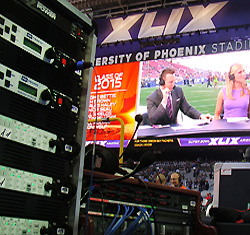
The recent football extravaganza – Rose Bowl, Pro Bowl and Super Bowl – meant plenty of audio professionals were busy making sure the hundreds of thousands in attendance as well as the hundreds of millions viewing the broadcasts heard the proceedings.
One of the key things that makes it all work is communication, as in constant crew communication, and it’s the job of the intercom (comm) systems to make that happen.
Particularly in light of the current turbulence in the world of RF (radio frequency), that’s becoming more challenging, especially at large-scale events where dozens if not hundreds of entertainment and broadcast wireless systems (microphones and IEM) are also deployed.
Noted RF coordinator James Stoffo (a contributor to this publication) is also now the chief technology officer for RAD (Radio Active Designs), established to devise new wireless technology for the pro production marketplace.
The company’s first development, the UV-1G wireless intercom system, was deployed at all three bowl games, where Stoffo served as RF coordinator (Rose Bowl) and entertainment RF engineer (Pro Bowl and Super Bowl, working with audio provider ATK Audiotek).
We’ve previously presented an in-depth overview of the UV-1G here. In brief, FM wireless intercom systems usually require 300 kHz of radio band to function properly. The UV-1G, with proprietary Enhanced Narrow Band technology, occupies less than 30 kHz of the VHF band. Further, a single UV-1G system works with up to six belt packs per base station, and up to six base station links, for a total of 36 ISO channels between packs.
“Our primary goal is spectral efficiency,” Stoffo explains. “We sought to vacate the UHF spectrum as much as possible, and as the FCC continues to auction off chunks of the UHF band, it becomes vital to have alternatives. More than half of the frequencies in use in productions are communications, so by switching to VHF, it leaves room for operation of other wireless devices.”
At the Rose Bowl stadium in Pasadena – also proximate to Mount Wilson, where all of the TV transmitters for Los Angeles are located – two UV-1G base stations and 12 belt packs were deployed to handle all intercom operations, opening up bandwidth for wireless mic and IEM systems.
Further, this year’s Super Bowl halftime entertainment headlined by Katy Perry serves as a prime example of the need to keep lines of communication open. “Katy used five different live wireless mics, which was a little challenging when it came to coordinating,” Stoffo explains. “It’s not necessarily life and death, but when she was flying through the air at one point? That’s when it gets important.”
In addition, with the VHF band virtually empty, comm users get their own channel, eliminating issues that may occur when forced to “double-up” on UHF. “That is a safety issue,” Stoffo states. “If comm operators are sharing a channel and key up at the same time, they cancel each other out. These people not only interface about the production, they also relay information about hazardous situations and can be a point person in a medical emergency. So it’s vital these systems work.”
For the Pro Bowl and Super Bowl, both held at the University of Phoenix Stadium a week apart, eight UV-1G base stations and 50 RAD packs were utilized by the NFL, ESPN and ATK AudioTek. “The NFL was extremely pleased with the systems,” Stoffo concludes. “The original plan was to test them out as back-ups on the sidelines, but the interference was so tremendous that they put them right to use during the Pro Bowl – and didn’t think twice about firing them up again for the Super Bowl.”

